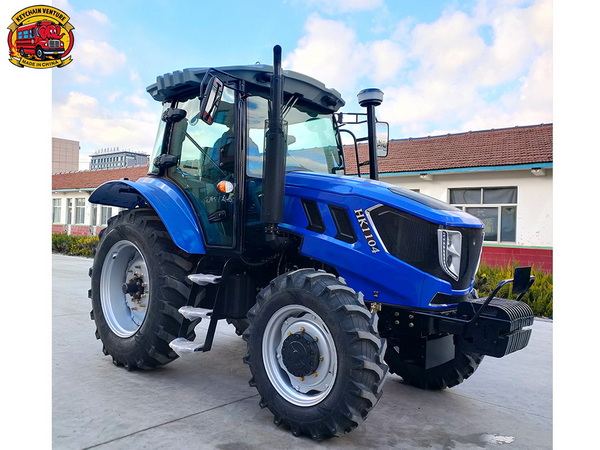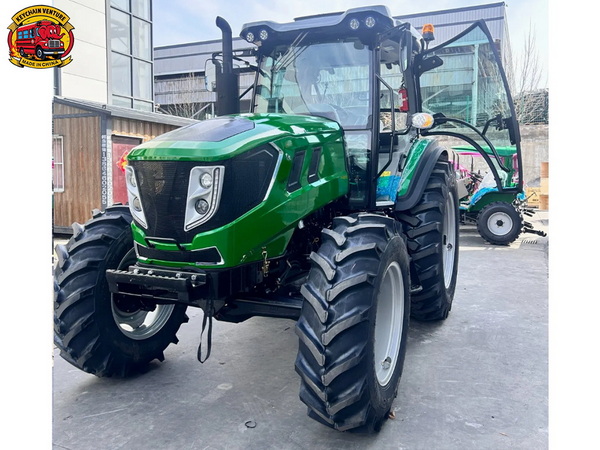Views: 222 Author: Amanda Publish Time: 2025-11-17 Origin: Site








Content Menu
● Dimensions and Physical Features
● Field Performance and Practical Usage
● Historical Context and Evolution
>> Comparisons with Other Classic Models
● Restoration and Collector Appeal
>> Trend Toward Classic Tractors
>> Impact of Width on Performance
>> Further Engineering Features
● Frequently Asked Questions (FAQ)
>> 1. What is the exact width of the Ford 8N Tractor?
>> 2. How much horsepower does the Ford 8N Tractor produce?
>> 3. What hydraulic features make the Ford 8N special?
>> 4. Can the Ford 8N Tractor be used with modern implements?
>> 5. Why is the Ford 8N still popular after so many years?
The Ford 8N Tractor represents an era of agricultural innovation that transformed farms worldwide. Since its debut in 1947, this classic utility tractor has become renowned for its durability, versatility, and iconic design. Its physical width—64.75 inches (164 cm)—provides the stability required for varied field conditions and supports a range of attachments, making the tractor a continuing favorite among enthusiasts and working professionals alike. This comprehensive guide explores the Ford 8N Tractor's measurements, engineering, practical applications, history, and enduring relevance on modern farms.[3][5][6][7]

The Ford 8N Tractor's width is 64.75 inches (164 cm), which allows it to perform well in plowing, tilling, and hauling tasks. Its core dimensions include:
- Length: 115 inches (292 cm)[5][3]
- Height: 54.5 inches (138 cm)[5]
- Wheelbase: 70 inches (177 cm)[3][5]
- Ground Clearance: 13 inches (33 cm)[5]
- Operating Weight: 2,410–2,717 lbs (1,093–1,232 kg)[6][3][5]
These measurements have proven ideal for small- to medium-size farms and terrain that demands both maneuverability and a robust footprint.
Both front and rear tread widths are adjustable between 48 and 76 inches to accommodate various field requirements and attachments. This flexibility enables farmers to optimize the tractor's performance for row spacing, soil conditions, and crop needs.[7]
The heart of the Ford 8N is a four-cylinder L-head gasoline engine, with the following specifications:[8][6][3][5]
- Displacement: 119.7 cubic inches (2.0 L)
- Bore/Stroke: 3.188 × 3.75 inches (81 × 95 mm)[8]
- Compression Ratio: 6:1 (early models), 6.7:1 (after serial number 85000)[5]
- Rated RPM: 2,000
- Torque: 92 lb-ft at 1,500 RPM
This engine provides the power needed for both agricultural operations and hauling requirements.
The Ford 8N introduced a 4-speed constant mesh transmission, a major upgrade over its predecessor models that only offered 3 speeds. An optional Sherman Combination transmission increased gear options to 12 forward and 3 reverse, further enhancing versatility. The tractor is equipped with mechanical steering, manual drum brakes, and an open operator station for simplicity of operation.[3][5]
The position control hydraulic system of the Ford 8N represented a significant leap forward, allowing operators to maintain implements at a selected height. Key hydraulic specs include:
- System Capacity: 5 gallons (18.9 L)
- Pressure: 1,700 psi (117.2 bar)
- Pump Flow: 2.85 GPM (10.8 lpm)[3][5]
- Three-point hitch (Category I)
- Rear lift capacity: 800 lbs (362 kg)[6][5]
- Rear PTO: transmission-driven, 545 RPM
These features allow operators to run a wide variety of tools, from mowers and tillers to posthole diggers and sprayers.
Thanks to its width and robust construction, the Ford 8N excels at:
- Plowing and tilling: Stable stance reduces slippage and ensures straight furrows.
- Grading and landscaping: Perfect for smoothing fields and lanes.
- Hauling capacity: Rear lift strength is ideal for moving logs, rocks, and supplies.[6]
- Attachments: Compatible with dozens of field and maintenance tools, maximizing utility.
Its open station provides excellent visibility and easy access, simplifying both daily use and periodic maintenance.
Operators appreciate the Ford 8N's smooth gearbox, responsive steering, and reliable hydraulic controls. Maintenance is straightforward due to the availability of parts and the simplicity of the design.

Produced from 1947 to 1952, the Ford 8N quickly gained status as the best-selling tractor of its era, with more than 524,000 units produced. Key innovations included:[3]
- Introduction of position-control hydraulics[5]
- Improved clutch and brake systems for greater safety and efficiency[10][5]
- Updated paint scheme: lighter gray sheet metal with a red body[10]
Today, restored Ford 8N tractors are valued by collectors and small farm owners for their unique combination of simplicity and capability.
Compared to the Ford 2N and 9N, the 8N boasts:
Feature | 9N/2N | 8N |
Transmission | 3-speed | 4-speed |
Hydraulics | Draft control only | Position control |
Brakes | Single | Independent |
Width | Similar, adjustable | 64.75 in, adjustable |
These upgrades maintain the 8N's place as a preferred model among vintage tractors.
The Ford 8N's robust design and open layout offer excellent accessibility for routine repairs. Tractor enthusiasts frequently restore these models due to the wide availability of replacement parts, detailed manuals, and strong online communities.
Many restoration projects focus on:
- Refurbishing engines and transmissions
- Replacing hydraulic components
- Restoring paint schemes to original gray and red
- Rehabbing the three-point hitch and lift controls
Successful restoration requires accurate measurement and alignment, made easier by the tractor's stable width and clear engineering.
Although surpassed by modern offerings in horsepower and advanced hydraulics, the Ford 8N remains popular in these roles:
- Hobby farming
- Property maintenance
- Teaching mechanics and tractor repair
- Community parades and exhibitions
Its enduring reliability and straightforward design make the Ford 8N an excellent choice for those seeking vintage tractor experience without heavy investment.
Collectors value the Ford 8N for its combination of history, mechanical ingenuity, and daily practicality. Its participation in tractor shows, historical demonstrations, and rural education projects continues to inspire interest.
The 64.75-inch width is more than a measurement—it's a key to stability:
- Enhances traction across uneven fields
- Permits mounting of wide implements without loss of balance
- Supports safe operation for towing and lifting
This classic sizing remains a blueprint for compact tractor models worldwide.
Additional innovations included a larger battery, improved charging system (generator, 20 amps, 6 volts, 80 AH), and positively-ground electrical system for easier starting and electrical reliability.[3][5]
The Ford 8N Tractor stands as an icon of agricultural progress. With its stable 64.75-inch width and advanced engineering, it redefined productivity on the farm in the mid-20th century and continues to play a meaningful role for today's collectors and small-scale operators. Its blend of simplicity, power, and versatility ensures the Ford 8N will always hold a special place in the world of tractors. Understanding every aspect—from size and specifications to practical usage and legacy—empowers anyone exploring vintage machines to make the best use of this classic utility tractor.

The Ford 8N Tractor's overall width is 64.75 inches (164 cm). Both front and rear tread widths are adjustable from 48 to 76 inches to suit different field tasks.[7][5][3]
The Ford 8N delivers 23.16 claimed drawbar horsepower, 27.32 claimed PTO horsepower, and tested values of around 22–25 horsepower, depending on specific measurements and operating conditions.[1][5][3]
Its position control hydraulic system allows the operator to precisely maintain implement height, a feature that revolutionized farm efficiency in the late 1940s.[5][3]
Yes, the standard three-point hitch (Category I) and PTO make it compatible with many contemporary implements, provided they do not exceed its lifting and power capacities.[6][3][5]
Its robust design, reliable mechanics, ease of maintenance, and historical legacy have kept it in demand among collectors, small farms, and hobbyists since its production ended in 1952.[11][10][6][3]
[1](https://www.tractorarmoury.co.uk/ford-tractors/ford-8n-tractor-specifications-30-hp)
[2](https://www.brokentractor.com/p/ford-8n-tractor-specs/)
[3](https://www.tractordata.com/farm-tractors/000/2/2/223-ford-8n.html)
[4](https://www.veritread.com/specs/agriculture/farm-tractors/ford/8n)
[5](https://www.fridayparts.com/blog/ford-8n-tractor-specs)
[6](https://8n-ford-tractor-specs.pages.dev/posts/8n-ford-tractor-specs/)
[7](https://fordtractorcollectors.com/service/specifications-and-data/)
[8](https://www.yesterdaystractors.com/fordnclub/specs.htm)
[9](https://www.youtube.com/watch?v=xf4KHuU7N2s)
[10](https://en.wikipedia.org/wiki/Ford_N-series_tractor)
[11](https://www.tractorbynet.com/forums/threads/8n-restored-with-pics.467373/post-6562748)